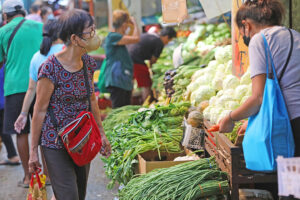Few ideas to bring down food prices

Finance Secretary Benjamin Diokno predicted in January that inflation peaked in December at 8.1%. Unfortunately, he misread the data because inflation spiked further to 8.7% in January 2023. According to the Philippine Statistics Authority (PSA), nine of 13 categories in January breached the Bangko Sentral ng Pilipinas’ 4% threshold for headline inflation, and two items — namely food prices and transport costs — were 10.7% and 11.2%, respectively. Prices of utilities increased by 8.5%.
Recently, Secretary Diokno once again forecast headline inflation going down in February. Reduced oil prices since January may lend support to his forecast, but that may fail to break the momentum. Alternatively, inflation may still go up to because of food prices. Sugar prices hogged the headlines in January and February. If landed sugar prices could be at P30 to P40 a kilo, local prices reached P100 a kilo in February. High sugar prices come after onion prices which were more expensive than beef.
The classic prescription of economists to reduce food prices involves increasing productivity and freeing up food importation. These still make sense in our view, but we may need to check on the competition environment surrounding food importation. Productivity programs are necessary but they are more a long-term solution to the problem of high food prices.
While the country must increase farm productivity, we must check at the same time if the statutory reductions of tariff barriers and extent of implementation of relevant international trade agreements such as the Agreements on Agriculture and Sanitary and Phyto-sanitary Measures are both supportive to effectively free up trade in food products.
Before we joined the World Trade Organization (WTO), food imports had been our last resort to avoid food shortages, and parastatals like the National Food Authority (NFA) were allowed to bring in the required imports. The private sector traders kept their hands off in the business of food imports. Shortages of food persisted when the NFA misread the supply and demand situation, delaying food imports. Thus, we had occasional food price crises linked to the inefficiency of the bureaucracy in designing and implementing productivity programs and importing food at the right time and volume.
Economists had clamored in those years to allow anyone to import food to stabilize food prices. However, the government resisted that in order to protect local farmers from competitive food imports.
The problem changed in a major way in 1995 when the Philippines joined the WTO as a founding member. As a member, the country is contractually bound to implement the worldwide agreement on Agriculture, among other obligations. The agreement called for the liberalization of food imports, reduced import duties on food items, and introduced international trade rules which support food import liberalization like transparency.
But there were features in the agreement that inadvertently had the promise of slowing down trade flows in food and agriculture. I refer to two items, the tariff rate quota system and the imperfect implementation of the SPS agreement.
TARIFF RATE QUOTA SYSTEMThe tariff rate quota system prescribes two tariffs on food imports, a higher tariff on imports above the quota, and a very low tariff rate on volumes within the quota. Each member in 1995 committed its out-quota tariffs which were typically exclusionary of imported food, and in-quota tariffs. Quotas were set to defend the three-year average food imports, and that was resorted to defend existing food trade in the global system. Over the next 10 years of implementation of the farm agreement, members committed to expand the quota and reduce the higher tariff on out-of-quota imports.
It may be observed that the Philippines saw in the system a way of controlling the volumes of food imports that come into the country. After the 10-year implementation, a member could slow down the reduction of out-quota tariffs, and manage the volume of import quotas to attain its economic and political objectives. Thus, the economy is stuck with redundant out-quota tariffs, and a quota system that regulators may calibrate to suit the political expediencies of the time.
The Agreement had stipulated that the tariff rate quota system was to be implemented in 10 years by developing countries but was silent on the need to lift such a system after 10 years. And therefore, we still have the tariff rate quota system which can be used to control food imports.
Had the WTO agreement on agriculture prescribed the dismantling of the tariff rate quota system after 10 years, global farm trade could have expanded significantly more than what the world had observed. Members willing to free up their trade can bring down out-quota tariffs to the level of the lower in-quota tariff, allowing free importation of food imports subject to the unified low import tariffs.
We did not do this, nor were WTO members obligated to dismantle the tariff rate quota system. Trade regulators inadvertently used the system to control market volumes, and that induced imperfect competition and spawned economic rents surrounding food importation. The allocation of the regulated quota went to the selected few winners through the minimum access volumes (MAV), and these few eventually were empowered to extract undue profits from food consumers.
IMPORT SPS-RELATED LICENSINGAnother creative way of controlling food imports has to do with the Agreement on Sanitary and Phytosanitary (SPS) Measures. This accord introduces disciplines in the exercise by member countries of their right to protect the health of their respective residents from diseases found in food imports, or their animal and plant populations from pests, or animal or plant diseases.
The agreement prescribes the following contractual obligations of members. The first is harmonization with international standards or, in their absence, to conduct a risk assessment to design an appropriate SPS measure to deal with the identified risk. Banning imports of chicken from countries with avian flu, for example, is an SPS measure. Other principles include equivalence, regionalization, control, inspection, and approval procedures and transparency.
In implementing the SPS agreement on food imports, importers are licensed by our food safety regulatory agencies, namely the Bureau of Plant Industry, Bureau of Animal Industry, National Meat Inspection System, Fertilizer and Pesticide Authority, Bureau of Fisheries and Aquatic Resources, Sugar Regulatory Administration, Philippine Coconut Authority, and National Dairy Authority.
The import licensing is automatic — that is, if the importer meets the SPS standards and technical regulations, the regulator has to issue the import license.
Regulators in practice exercise discretion in the granting of import licenses. If there is a need to control the volume so that food prices do not go down as much, they could delay the granting of the licenses or disapprove the applications for whatever reasons. Denied applicants could challenge the decision of regulators, but that has a cost and they may just abandon their plan to import food. Others who mastered the game of getting import licenses remain and could control food market prices.
An assessment done by the Standards and Trade Development Facility (STDF) of the WTO Secretariat, and supported by another study on the Trade Policy Review by the WTO Secretariat in 2017, says that there is evidence that the licensing and permitting system is often used for controlling volume (resulting in higher prices to consumers). The 2017 Trade Policy Review noted that “some traders believe that quotas applied in licenses and permits aim at control of markets, not protection of health.”
The imperfect compliance of the country to its contractual obligations under the WTO SPS agreement, like the tariff rate quota system, breeds economic rents.
HOW TO FREE UP EFFECTIVELY FOOD IMPORTSOne possible measure is to remove import licensing. Opponents to this idea will raise the concern that this proposal introduces pests, diseases, and so on into our country. Remember African Swine Fever? That one came to us through imports. That is a valid objection and let me deal with that by invoking the principle of equivalency, one of the principles of the SPS agreement.
The study by the STDF asserts that according to the SPS Agreement’s equivalence principle, safety assurances from reputable foreign sources should be accepted. Import licensing has limited contribution to ensuring public, animal or plant health if exporting countries provide safety assurances for the food they export to us.
Food safety regulators can facilitate this by publishing countries which we can safety import from. If there are new sources of food imports, then we conduct a risk assessment.
By freeing up import licensing with publication on safe sources of food imports, we allow more traders to go into the food import business. Presently, there are only a few traders who are into importing, those who understand the SPS agreement and the tariff rate quota system. Competition is needed to prevent a few from profiteering, and that is promoted if we lift the import licensing system for SPS.
A second possible measure is to dismantle the tariff rate quota system. This can be done by bringing down the out-quota tariff rate on food imports to the level of the in-quota tariff rate. This can be done by the President, exercising his power to adjust tariffs under Section 401 of the country’s tariff code. This move is consistent with our obligations under the Agreement on Agriculture.
‘BIG LIE’ OF AGRICULTURE POLICYHow about the “poor farmers”? They will be happy because in most days of the year they are food consumers. Opponents of freeing up further food imports argue that farm incomes will go down because of uncontrolled food imports. We want food imports to come in as much as possible to reduce food prices and raise real household incomes including those of the poor farmers.
It is about time that we deal squarely with this “big lie” in agriculture. The majority of our “poor farmers” are small holders. If farm prices go down, incomes will go down but asking consumers to pay a higher price on food imports is the wrong way to address the problem. We need higher productivity to sustainably increase farm incomes. It is true that their costs may exceed farm prices and we need to deal with that problem, with effective productivity programs, particularly of the private sector in partnership with the Department of Agriculture. Higher productivity can reverse the present lack of competitiveness of our agriculture sector.
HIGHER FARM LAND OWNERSHIP FOR PRODUCTIVITY GAINSIn a previous contribution, I argued that we need to lift the ceiling on farm market ownership in order to attract private sector investments into agriculture. Let the proposed debt condonation law benefiting agrarian reform beneficiaries remove existing ceilings, or at least raise the ceiling to, say, 25 hectares from the current five hectares. We must make farm markets more responsive to our need of improving farm productivity, by freeing up the buying and selling of farm hectares to ensure that they can be developed most productively.
Investments are needed in order to raise productivity, and those with capital come into agriculture if they can have reasonable economies of scale and security of tenure. Given that we had already implemented the comprehensive agrarian program, we may consider encouraging farmers to do group farming. If they do not have capital to do this, they could link up with private sector investors in agriculture. They own the land, and will be compensated by the investors for the use of their land. They could work on the farm and generate extra income.
Ramon L. Clarete is a professor at the University of the Philippines School of Economics.




